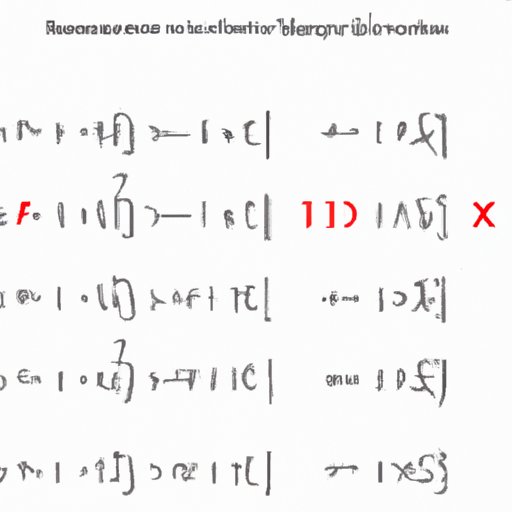
I. Introduction
Have you ever wondered how to represent data in a way that is more meaningful and informative? Look no further than relative frequency, a statistical measure that can help you make sense of data by showing the proportion of each category relative to the total. In this article, we will explore the concept of relative frequency and how to calculate it, as well as its real-world applications and mathematical background.
II. Understanding Relative Frequency
Relative frequency is a statistical measure that shows the proportion of each category relative to the total. It is calculated by dividing the frequency of a particular category by the total frequency of all categories. This helps to put the data into context and allows for more meaningful interpretation.
For example, let’s say we are analyzing the results of a survey that asked individuals to rate a product on a scale of 1 to 5. By calculating the relative frequency for each rating, we can see the distribution of responses and identify any patterns or trends.
III. The Formula and Calculations for Relative Frequency
The formula for calculating relative frequency is:
Relative Frequency = Frequency of Category / Total Frequency
To calculate relative frequency, you first need to determine the frequency of each category and the total frequency for all categories. Once you have this information, you can use the formula to calculate the relative frequency for each category.
Let’s look at an example to see how this works. Suppose we have the following data:
Category A: 25
Category B: 15
Category C: 10
Total: 50
To calculate the relative frequency for Category A, we would divide the frequency of Category A (25) by the total frequency (50), which gives us 0.5 or 50%. So the relative frequency for Category A is 50%.
You can repeat this process for each category to determine the relative frequency for all categories.
IV. Real-world Applications of Relative Frequency
Relative frequency is an important statistical measure that has many real-world applications. It can be used to analyze survey data, monitor trends in business, and identify patterns in any kind of data set.
For example, in business, relative frequency can be used to track sales of different products or identify target demographics for marketing campaigns. In healthcare, it can be used to monitor the prevalence of certain diseases or conditions.
By identifying patterns and trends through relative frequency calculations, businesses and organizations can make informed decisions and improve their overall performance.
V. Infographic or Visual Representation of Relative Frequency
One way to better understand relative frequency is through the use of graphics, charts, and diagrams. By visualizing the data, you can identify patterns and trends more easily.
For example, a pie chart can be used to show the relative frequency of each category in a data set. A bar graph can be used to show the frequency of each category and the total frequency side-by-side.
VI. Mathematical Background of Relative Frequency
Relative frequency is a mathematical concept that is closely related to other statistical measures, such as absolute frequency and percentage frequency. It is based on the idea of proportions, which is a fundamental concept in mathematics.
By understanding the mathematical background of relative frequency, you can better appreciate its significance and its relationship to other statistical measures.
VII. Comparative Analysis of Relative Frequency
When it comes to data analysis, there are many statistical measures that can be used to represent data. One way to understand the significance of relative frequency is to compare it to other measures, such as absolute frequency and percentage frequency.
Absolute frequency measures the number of times a particular category appears in the data set. Percentage frequency measures the proportion of a particular category relative to the total number of categories.
Relative frequency provides a way to compare the frequencies of different categories on a common scale, which can make it easier to identify patterns and trends.
VIII. Frequently Asked Questions about Relative Frequency
What is relative frequency and why is it important? How do you calculate it and what are some real-world applications? These are just a few of the common questions that people have about relative frequency.
In this section, we will answer these questions and more, providing a helpful resource for anyone looking to improve their data analysis skills.

IX. Examples and Exercises of Relative Frequency Calculations
To help you practice your relative frequency calculations, we have included multiple examples and exercises in this section. Each example includes step-by-step solutions and explanations, making it easy to follow along and understand the process.
X. Conclusion
Relative frequency is a powerful statistical measure that can be used to analyze data, identify patterns and trends, and make informed decisions. By understanding how to calculate and interpret relative frequency, you can improve your data analysis skills and make more informed decisions in all aspects of life.
We hope that this comprehensive guide has been helpful in understanding relative frequency and its significance. If you have any further questions or would like more information, please don’t hesitate to reach out.





